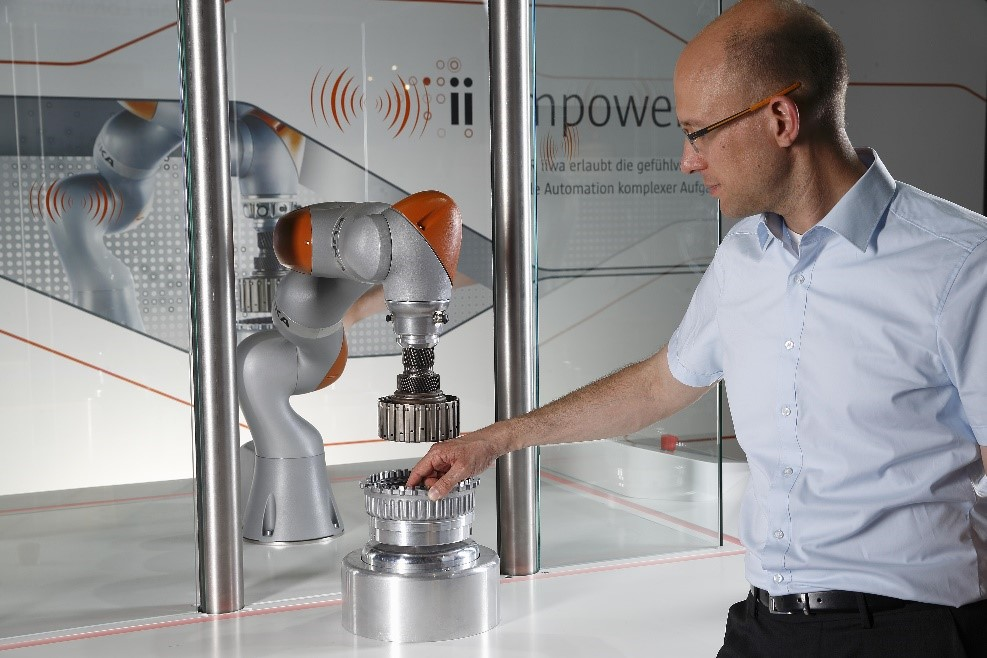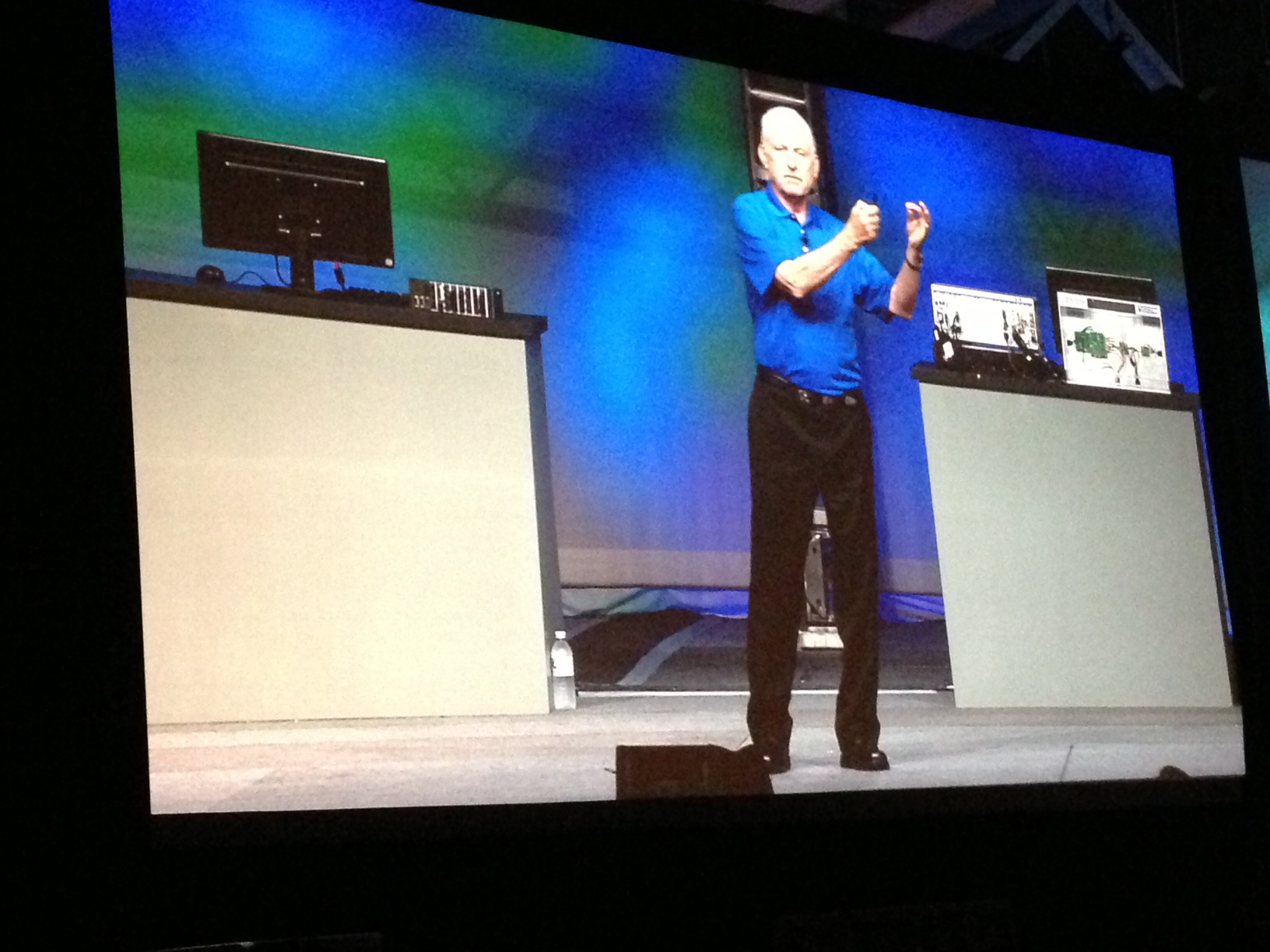
by Gary Mintchell | May 6, 2015 | Automation, Internet of Things, Manufacturing IT, News, Operations Management, Technology
 In the rush of a lot of news and a vacation thrown in, I’m still digesting news from Hannover Messe in April. Microsoft had called and asked if I could stop by for an interview, but unfortunately I was not at Hannover.
In the rush of a lot of news and a vacation thrown in, I’m still digesting news from Hannover Messe in April. Microsoft had called and asked if I could stop by for an interview, but unfortunately I was not at Hannover.
Below is a Microsoft blog post. The writer posits three industrial ages, and then he surprises us by announcing the arrival of a fourth. Interestingly, it is at Hannover two years ago where Industrie 4.0 sprang forth into our consciousness. Here is Microsoft’s take on the fourth generation of manufacturing along with a few specific examples of what it means in practice.
I think this is a good, though not necessarily complete, look at aspects of Industry 4.0.
From the blog
When we think about what it takes to build a successful business, there were three main eras, which characterized important shifts in the global marketplace. The first was the industrial revolution when people began to mass-produce and distribute goods with tremendous scale and efficiency. Since everyone received information at the same time and speed was not an issue, change wasn’t particularly fast.
What followed was the Information Age where people weren’t just using technology to drive production efficiencies; they were using it to drive information efficiencies. During this time, competitive advantage began to shift to our access to information.
Today, information and data are ubiquitous which has had a tremendous effect on both our digital work and life experiences. The world has formed a giant network where everyone has access to anyone and everything. Some people refer to this as the Connected Age.
However, the ubiquity of data and connected devices, coupled with important advances in machine learning, are powering a new set of capabilities called the Internet of Things (IoT). IoT is now at the forefront of a fourth era in business productivity. With IoT, companies worldwide are transforming the way they plant crops, assemble goods and maintain machinery. Now, several Microsoft customers and partners, including Fujitsu, KUKA Robotics, and Miele, are announcing IoT initiatives that will change the way people live and work.
IoT’s influence on those companies and many others is on display this week at the large industry fair Hannover Messe, where the term “Industry 4.0” was first coined. Everywhere we look there are examples of physical assets integrated with processes, systems and people, and exciting possibilities are being fueled by this transformation.
At this event, Microsoft is showing how we’re helping manufacturers innovate, bring products to market more quickly and transform into digital businesses. Aided by unlimited compute power and rich data platforms, the creation of “systems of intelligence” that enable reasoning over vast amounts of data are empowering individuals and organizations with actionable insights.
Blending physical with digital
Fujitsu is bringing together its Eco-Management Dashboard, IoT/M2MP platform, Microsoft cloud services, and Windows tablets in a way that can enable managers, engineers, and scientists to improve product quality, streamline systems, and enhance functionality while reducing costs. For example, at its facility in Aizu Wakamatsu, Japan, Fujitsu is able to grow lettuce that is both delicious and low in potassium so that it can be consumed by dialysis patients and people with chronic kidney disease. They can track all of the plant info from their Windows tablets through the cloud. These solutions will also be able to help other agriculture and manufacturing companies transform their businesses through innovation.
Artificial intelligence is no longer a fantastic vision for the future—it is happening today. KUKA, a manufacturer of industrial robots and automation solutions, is using the Microsoft IoT platform to create one of the world’s first showcases that blends IT with robotic technologies into a smart manufacturing solution with new capabilities.
Intelligent Industrial Work Assistant (LBR iiwa), a sensitive and safe lightweight robot, uses precise movements and sensor technology to perceive its surroundings around a complex task like performing the delicate action of threading a tube into a small hole in the back of a dishwasher. Errors in the supply chain are addressed in real time through Windows tablets, making the automated process faster and easier. Through this demonstration, KUKA is highlighting how its LBR iiwa can collaborate with humans to jointly perform the task as peers working together without being controlled by a human or using a vision system.
Eyeing physical assets through a digital lens
For companies trying to understand how this approach can help, look at the infrastructure you already have. How can these assets become connected and intelligent? What kind of data would help to reduce cost, or increase agility? How can you use insights to grow revenue in existing operations, or offer those insights to customers and create new revenue streams?
The focus here is on transforming existing business models and adding cloud-connected services. In the age of Industry 4.0, manufacturing and resource companies will no longer compete over the products and features they offer, but on new business models they can either pursue themselves or offer to customers.

by Gary Mintchell | Nov 5, 2014 | Automation, Leadership, News, Operations Management, Organizations
 The Smart Manufacturing Leadership Coalition (SMLC) has announced that the SMLC Executive Committee has elected Michelle Pastel of Corning Inc., to serve as Secretary on the Board of Directors, effective immediately.
The Smart Manufacturing Leadership Coalition (SMLC) has announced that the SMLC Executive Committee has elected Michelle Pastel of Corning Inc., to serve as Secretary on the Board of Directors, effective immediately.
In search for a new Secretary position, the Executive Committee sought a candidate who would represent the voice of the manufacturing industry to further strengthen SMLC’s leading position in Smart Manufacturing through ensuring industry alignment. Michelle Pastel has already made a positive impact on driving SMLC’s technology development and commercialization plans.
SMLC CEO Denise Swink, states, “Michelle Pastel is leading a corporate renaissance in Corning, exploring and embracing Smart Manufacturing philosophies and potential. We are very fortunate for her leading Corning’s representation in SMLC and contributing her experiences, ideas and enthusiasm for leveraging collaboration opportunities with other SMLC members. She will be a key component of the Executive Committee leadership.”
Michelle Pastel earned her degree in Electrical and Computer Engineering from the University of New Mexico. She joined Corning in 1993 as a Systems Engineer, and is currently the Manager of Measurements, Controls, and Systems Innovation in Corning’s Manufacturing Technology and Engineering Division, Advanced Engineering Directorate, focused on collaborating with Science & Technology, as well as Corning’s businesses, to deliver differentiating technology solutions in the areas of measurements, advanced process control, laser processing, imaging systems, and systems integration technologies for products and processes to enable Corning’s research and development programs to innovate new products and manufacturing processes.
Throughout Pastel’s career, she has held technology, engineering and manufacturing positions in many divisions including Corning Optical Fiber, Components Products, Photonics Technology, Optical Networking Devices, and MTE. These roles have included Production Support Leader, Technical Support Leader, New Product Introduction Leader, Process Development Leader, Technology Demonstration Leader, Portfolio Manager, Project Manager, and Department Manager. Through her work in MTE, she also has experience in other businesses including Corning Asahi Video, Consumer Products, American Video, Integrated Die Manufacturing, and S&T.
“I am honored to be given this opportunity and thrilled to be working for the SMLC in this capacity,” states Pastel. “As we work together to implement the Smart Manufacturing philosophy and create the systems that support it, we will undoubtedly improve US manufacturers’ competitive position in the world. This will be an industrial revolution of sorts and I’m excited to be a part of making it possible for each of our organizations.”
SMLC Treasurer, Tom Edgar, states, “Through her practitioner lens, Michelle’s enthusiasm, leadership and commitment to transform the manufacturing industry have proved to be a major contribution to SMLC’s success.”
On July 12, Jim Wetzel, Technical Director at General Mills, accepted the position as SMLC’s new Chair. Wetzel states, “We believe Michelle Pastel represents an ideal champion for Smart Manufacturing; she has demonstrated great leadership skills through identifying opportunities within Corning to leverage and contribute to SMLC’s comprehensive smart manufacturing initiative. The SMLC is honored to have Michelle serve on the Executive Committee and provide a critical role to achieving SMLC’s vision and mission.”
Important information about the organization
The SMLC is a non-profit organization comprised of manufacturing practitioner, supplier, and technology companies; manufacturing consortia; universities; federal agency and government laboratories. SMLC is building the nation’s first open SM Platform for collaborative industrial-networked information applications through at-scale demonstrations. The SM Platform enables manufacturing companies of all sizes to gain easy, affordable access to modeling and analytical technologies that can be tailored to meet cross-industry business-case objectives without having to retrofit existing systems.
SMLC envisions a 21st century SM enterprise (from suppliers, OEMs, and companies to supply chains) that is fully integrated, knowledge-enabled, and model rich. Such visibility across the enterprise (internal and external) would radically improve the ability to inform decisions and drive action.
Partners Involved: Advanced Manufacturing Partnership for Southern California (AMPSoCal); American Council for an Energy-Efficient Economy (ACEEE); Alcoa; American Institute of Chemical Engineers; American Society of Quality (ASQ); Association of State Energy Research & Technology Transfer Institutions (ASERTTI); ARC; CalTech – Jet Propulsion Laboratory; Corning; DOE; Emerson; Electric Power Research Institute (EPRI); General Dynamics; General Electric; General Mills; General Motors; Manufacturing Enterprise Solutions Association (MESA); MTConnect Institute; National Association of State Energy Officials (NASEO); North Carolina State University (NCSU); Nimbis Services, Inc.; NIST; NSF; OSIsoft; Owens Corning; Pfizer Inc.; Praxair; Purdue University; Rockwell Automation; Rensselaer Polytechnic Institute (RPI); Savigent Software; Schneider Electric; Society of Manufacturing Engineers (SME); Southwest Research Institute (SWRI); Spitzer and Boyes LLC; Sustainable Solutions; Tulane – Center for Polymer Reaction Monitoring and Characterization; UCLA; University of Texas – Austin

by Gary Mintchell | Aug 8, 2014 | Automation, Education, Internet of Things, News, Operations Management, Technology, Wireless

Starkloff, Fettweis, Salvo, Hatch
The third day keynote session at NI Week always features the achievements of students, academics and futurist thinkers. Eric Starkloff, National Instruments’ executive Vice President of Global Sales and Marketing, introduced the session by reminding us of the “Engineering Grand Challenges:” health, sustainability, security, and joy of living. “How do we inspire and train future engineers to tackle these problems?” he challenged the audience.
Dave Wilson: director of academic programs for NI, took us back to issue of time first introduced in CEO James Truchard’s Day One keynote. “Time pieces are infinitely more complex today,” he noted. “And look at transportation. Early automobiles were fundamental systems; new ones, such as the Tesla S, are significantly more complex.”
Do Engineering
So how do we train engineers to keep up and expand on these increasingly complex problem? “Do Engineering” is the theme. We get better through practice. Especially practice with something that maintains consistency over time. NI’s graphical programming system is used by young people with Lego Mindstorms up through engineers solving complex problems. NI’s new MiniSystems help students continue to learn. Over time, NI has reached 4,000,000 “future systems designers”.
Research competition using MyRIO has involved students in 65 countries, 850 universities, 20,000 students. This year 3,250 teams 25 countries entered the student design competition. Three finalists were invited to NI Week. A team from UNC Charlotte developed a NASA launch project for reusable rockets. Students from the Korea Advanced Institute of Science and Technology developed the EureCar, a self-driving car. Introducing the winner, Wilson noted that today’s engineers often take cues from biology such as the study of geometries of soles of frogs for designing tires. This finalist, students from ETH Zurich, took cues from marine life. Studying cuttlefish, the winners build a submarine propulsion mechanism enabling study of marine life without as much disruption as current robots submarines using myRIO and LabView.
Turning to academics, Wilson introduced a trio of professors from MIT. One led a team that developed the world’s largest range high-speed atomic force microscope. Another took the NI technology used in that project and scaled it down for graduate engineering student labs. And the Engineering Impact Award, which attracted 120 papers, went to the third MIT professor who developed “Portable Labs” a small FlexRIO board and with a vibrating strip of metal and magnet for undergraduate students to learn mechatronics. “We know that students want to do engineering not just sit and listen about it.” Amen to that. And, you, too, can own a FlexLab for myRIO for <$50 from MIT.
Future of Engineering
Starkloff introduced the three technology leaders, Mark Hatch, Joe Salvo and Gerhard Fettweis, who each had a short presentation followed by one of the few good panel discussions I’ve seen.
Leader of maker movement, Mark Hatch, CEO of TechShop, author of “The Maker Movement Manifesto”, and recipient of many awards for leading innovative maker communities in many cities, asked attendees, “What will you make? It’s cheaper now than ever before to innovate and make new things.”
Joe Salvo heads GE Global Research, which founded the Industrial Internet Consortium that NI recently joined. The goals of IIC are to break tech silos, bring physical/digital worlds together, and realize promise of M2M. Industrial Internet evolving manufacturing from the systems age. The global community is now connected both in business and socially. First people connected through cellular phones. Then he asked, “How many friends does your computer have? My computer has an active night life after I go to bed getting updates, etc. We have formed enormous value by connecting people, now include all the “things” think of the value that will be created. We are in a New Industrial Revolution with advanced manufacturing using the digital thread. FIrst we replaced back breaking work, then replaced routine work, now brilliant machines and brilliant minds coming together to work jointly.”
Technische Universitat Dresden professor Gerhard Fettweis has cofounded 11 startups. He is now researching wireless for the development of 5G cellular. Showing juxtaposed pictures from the introduction of Pope Benedict to the introduction of Pope Francis just a few years later reveals how the wireless community has changed the planet and glimpse of future. In the first picture one mobile phone is seen in the crowd. In the second, it seems everyone has a smart phone or tablet taking pictures of the event. He is researching a tactile internet where man and machine can meet in real-time control. This will require network latency down to 1 msec.
What are you doing to advance the world?

by Gary Mintchell | Aug 6, 2013 | Automation, Technology
 Dr. James Truchard, president and CEO of National Instruments, kicked off the 2013 edition of the company’s user conference–NI Week. Once again he spoke passionately about the ability of technology to solve complex problems–in industry as well as many other fields.
Dr. James Truchard, president and CEO of National Instruments, kicked off the 2013 edition of the company’s user conference–NI Week. Once again he spoke passionately about the ability of technology to solve complex problems–in industry as well as many other fields.
Recounting the history of instrumentation from vacuum tubes through transistors to software (LabView), he compared iOS apps to virtual instrumentation–going so far as to refer to a bagpipe tuning app on an iPhone.
Turning to a topic I wrote about last April from when I was in Hanover, Germany, he discussed the so-called Fourth Industrial Revolution, or Industrie 4.0 in Germany. The foundation of the new theory is “cyberphysical” systems. Truchard pointed out that he spoke about this topic seven years ago. LabView from its inception has pointed toward cyberphysical systems. “We have the technology to move industry forward,” he stated.
Promoting graphical system design, he noted the advancements of the past few years for doing advanced measurement and advanced control in one system. “We want to do for cyberphysical systems what the PLC did for discrete control,” he proclaimed.
Regarding the vast amount of data now available from all the connected devices, Truchard noted that “more is different” when referring to “Big Analog Data.” The company always had the mantra of acquire, analyse, present. Formerly that referred to one engineer acting locally. Now with the cloud and big analog data that same mantra assumes an entirely different and larger purpose.

 In the rush of a lot of news and a vacation thrown in, I’m still digesting news from Hannover Messe in April. Microsoft had called and asked if I could stop by for an interview, but unfortunately I was not at Hannover.
In the rush of a lot of news and a vacation thrown in, I’m still digesting news from Hannover Messe in April. Microsoft had called and asked if I could stop by for an interview, but unfortunately I was not at Hannover.









